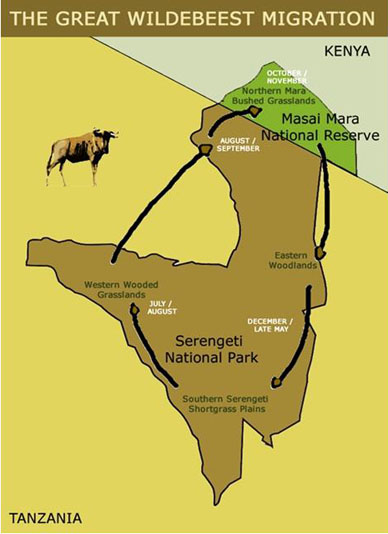Probably the most world-famous tourist attraction in Tanzania is the Serengeti National Park. Serengeti means “endless plains” in the Maasai language. This 15,000-square-kilometer park is situated in the northern part of the country and is contiguous to the Maasai-Mara Park in Kenya. This area is most noted for the annual migration of over 2 million animals, including 1.5 million wildebeest, 200,000 zebra and 500,000 gazelle. The migration is driven by the search for water.

Beginning in June and continuing through July, animals move north in a clockwise direction initially crossing the Grumeti River in the Serengeti. In August, the animals arrive at the Mara River, cross it and end up in the lush plains of the Maasai Mara Game Reserve. They remain there through September and October. In November, when grazing pastures in the Maasai Mara become scarce, animals migrate back to the short grass in the southeastern Serengeti plains, which by this time have received adequate rainfall. They remain there from December to March. During this time, the wildebeest give birth to over 400,000 offspring. The wildebeest slowly move northwest in April and May to the Serengeti’s western corridor, which has received abundant rains. When the grass withers, the animals move north once again and a new cycle begins.
This is the largest migration on earth and the animals cover over 1600 kilometers annually. River crossings represent their greatest threat, where the weak and injured fall prey to predators including lions, cheetahs, wild dogs, jackals and crocodiles.
To follow the migration, &BEYOND have established two mobile luxury tent camps each containing eight tents. There is a comfortable bed and bathroom with a bucket shower. Each tent is furnished with Indian rugs and polished brass decorations. Electricity is supplied by a generator. Dinner is served under the stars. A personal butler is assigned to each tent.
These seasonal camps move around the Serengeti to follow the migration. It takes three days to dismantle a camp and another four days to establish a new one. This is done in designated areas. None of the &BEYOND camps are fenced in and animals are free to come and go. For this reason, it is only permitted to wander about after dark under the watchful eye of a ranger.
One evening when we were having dinner in the open under a campfire in this tent camp, a hippo charged across the open area five meters away from us. Later when we were being escorted to our tent by our ranger, we were again accosted by a hippo. “Freeze,” whispered the ranger. We readily complied and after a few anxious moments, the hippo wandered off aimlessly. At night we could hear hippos bellowing outside our tent.
Because of its unique nature, Serengeti has been recognized as World Heritage Site. One disturbing piece of news is that the current Tanzanian government is considering building a highway across the northern part of the Serengeti through the migration route. If carried out, this could represent an ecological disaster since it could potentially interrupt the migration.
Figure 1: Map of migration
Figure 2: Wildebeest migration
Figure 3: Hippo
This article was originally published in the Jerusalem Post.
Additional pictures from this as well as other trips are available at www.pbase.com/irvspitz.
Further articles and reviews can be seen at www.irvingspitz.com.



